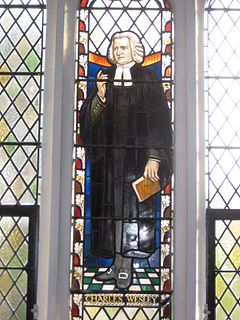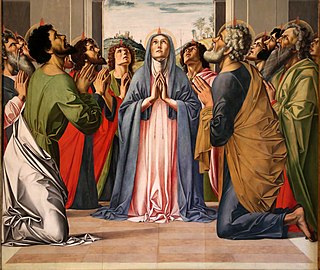The Finlandia hymn refers to a serene hymn-like section of the patriotic symphonic poem Finlandia, written in 1899 and 1900 by the Finnish composer Jean Sibelius. It was later re-worked by the composer into a stand-alone piece. With words written in 1940 by Veikko Antero Koskenniemi, it is one of the most important national songs of Finland. Although not the official national anthem of Finland, it has been continuously proposed as such.

Frances Jane van Alstyne, more commonly known as Fanny Crosby, was an American mission worker, poet, lyricist, and composer. She was a prolific hymnist, writing more than 8,000 hymns and gospel songs, with more than 100 million copies printed. She is also known for her teaching and her rescue mission work. By the end of the 19th century, she was a household name.

"Be Thou My Vision" is a traditional Christian hymn of Irish origin. The words are based on a Middle Irish poem that has traditionally been attributed to Dallán Forgaill.

"O for a Thousand Tongues to Sing" is a Christian hymn written by Charles Wesley. The hymn was placed first in John Wesley's A Collection of Hymns for the People Called Methodists published in 1780. It was the first hymn in every (Wesleyan) Methodist hymnal from that time until the publication of Hymns and Psalms in 1983.

Phoebe Palmer Knapp was an American composer of music for hymns and an organist.

"Abide with Me" is a Christian hymn by Scottish Anglican Henry Francis Lyte. A prayer for God to stay with the speaker throughout life and in death, it was written by Lyte in 1847 as he was dying from tuberculosis. It is most often sung to the tune "Eventide" by the English organist William Henry Monk.

Cwm Rhondda, taken from the Welsh name for the Rhondda Valley, is a popular hymn tune written by John Hughes (1873–1932) in 1907.

Robert Lowry was an American preacher who became a popular writer of gospel music in the mid- to late-19th century. His best-known hymns include "Shall We Gather at the River", "Christ Arose!", "How Can I Keep from Singing?" and "Nothing But The Blood Of Jesus".

A Christian child's prayer is Christian prayer recited primarily by children that is typically short, rhyming, or has a memorable tune. It is usually said before bedtime, to give thanks for a meal, or as a nursery rhyme. Many of these prayers are either quotes from the Bible, or set traditional texts.
"Jesu, Joy of Man's Desiring" is the most common English title of a piece of music derived from a chorale setting from the cantata Herz und Mund und Tat und Leben, BWV 147, composed by Johann Sebastian Bach in 1723. The same music on different stanzas of a chorale closes both parts of the cantata.

"All the Way My Savior Leads Me" is a Christian hymn with lyrics written in 1875 by Fanny J. Crosby (1820-1915) to a tune written by the Baptist minister Dr. Robert Lowry.
Beulah is a land referred to in the Biblical Book of Isaiah. It is the land of the Jewish people, the Israelites, to which they must return: an earthly paradise.
Charles Ernest Moody was a gospel songwriter from Gordon County, Georgia, United States. He was a member of the 1920s string band Georgia Yellow Hammers from Calhoun, Georgia, which included members Bill Chitwood, Bud Landress, and Phil Reeve. The Yellow Hammers were a very popular string band with their biggest hit being "Picture on the Wall" which sold more than sixty thousand copies in 1928. Moody's individual songwriting talents were, however, dynamic.

"I am Thine, O Lord" is one of many hymns written by Fanny Crosby, a prolific American hymn writer. The melody was composed by William Howard Doane. The former was talking with the latter one night about the proximity of God and penned the words before retiring for the night. It has also been reported that Fanny Crosby, though blind, had a sunset described to her in words before writing the lyrics. Hebrews 10:22 is reported as being a source of inspiration for the hymn:

"Day by Day " is a Christian hymn written in 1865 by Lina Sandell several years after she had witnessed the tragic drowning death of her father. It is a hymn of assurance used in American congregational singing.

"This joyful Eastertide" is an 1894 Easter carol. The words are by George Ratcliffe Woodward, the tune is from the Netherlands (1624), and the 1894 harmonisation is by Charles Wood.
"Ermuntre dich, mein schwacher Geist" is a German Christmas carol with lyrics by Johann Rist and a melody by Johann Schop, first published in 1641. Historically it was contained in Protestant hymnals, but the current one, Evangelisches Gesangbuch, uses only three of its stanzas, the ninth, the second and the twelfth, titled "Brich an, du schönes Morgenlicht". This stanza was used by Johann Sebastian Bach as a chorale in Part II of his 1734 Christmas Oratorio.
How sweet the name of Jesus sounds is a hymn by the evangelical Anglican cleric John Newton. It was published in Olney Hymns in 1779. Of a metaphorical nature, it focuses on the power of the name of Jesus. It is often sung to the tune of Saint Peter by Alexander Reinagle and less frequently to Ortonville by Thomas Hastings. A modern alternative tune is Rachel by Chris Bowater.

"Come Down, O Love Divine" is a Christian hymn usually sung for the festival of Pentecost. It makes reference to the descent of the Holy Spirit as an invocation to God to come to into the soul of the believer. It is a popular piece of Anglican church music and is commonly sung to the tune "Down Ampney" by Ralph Vaughan Williams.











